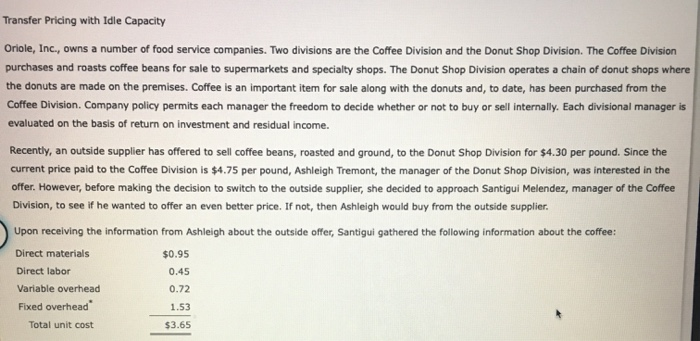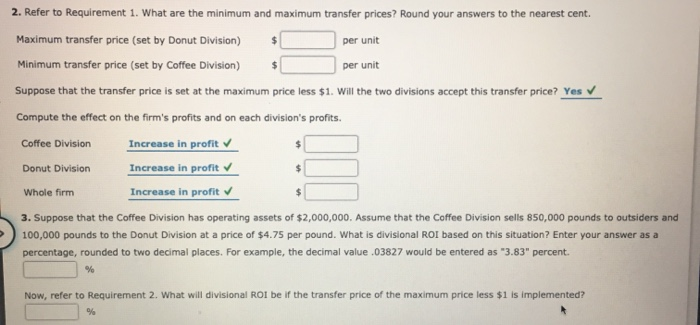Transfer Pricing with Idle Capacity Oriole, Inc., owns a number of food service companies. Two divisions are the Coffee Division and the Donut Shop Division. The Coffee Division purchases and roasts coffee beans for sale to supermarkets and specialty shops. The Donut Shop Division operates a chain of donut shops where the donuts are made on the premises. Coffee is an important item for sale along with the donuts and, to date, has been purchased from the Coffee Division. Company policy permits each manager the freedom to decide whether or not to buy or sell internally. Each divisional manager is evaluated on the basis of return on investment and residual income. Recently, an outside supplier has offered to sell coffee beans, roasted and around, to the Donut Shop Division for $4.30 per pound. Since the current price paid to the Coffee Division is $4.75 per pound, Ashleigh Tremont, the manager of the Donut Shop Division, was interested in the offer. However, before making the decision to switch to the outside supplier, she decided to approach Santigui Melendez, manager of the Coffee Division, to see if he wanted to offer an even better price. If not, then Ashleigh would buy from the outside supplier. Upon receiving the information from Ashleigh about the outside offer, Santigui gathered the following information about the coffee: Direct materials Direct labor Variable overhead Fixed overhead Total unit cost $0.95 0.45 0.72 1.53 $3.65 Fixed overhead is based on $1,530,000/ 1,000,000 pounds. Selling price per pound $4.75 Production capacity 1,000,000 pounds 100,000 pounds Internal sales 1. Now, assume that the Coffee Division is currently selling 950,000 pounds. If no units are sold internally, total coffee sales will drop to 850,000 pounds. Suppose that Santigui refuses to lower the transfer price from $4.75 and the Donut Division purchases from the external supplier. Compute the effect on each division's profits and on the profits of the firm as a whole. Enter an increase in profits as a positive amount, and enter a decrease as a negative amount. Change in profit for Coffee Division Change in profit for Donut Division Overall firm impact 2. Refer to Requirement 1. What are the minimum and maximum transfer prices? Round your answers to the nearest cent. Maximum transfer price (set by Donut Division) per unit Minimum transfer price (set by Coffee Division) $ per unit Suppose that the transfer price is set at the maximum price less $1. Will the two divisions accept this transfer price? Yes Compute the effect on the firm's profits and on each division's profits. Coffee Division Increase in profit Donut Division Increase in profit Whole firm Increase in profit 3. Suppose that the Coffee Division has operating assets of $2,000,000. Assume that the Coffee Division sells 850,000 pounds to outsiders and 100,000 pounds to the Donut Division at a price of $4.75 per pound. What is divisional ROI based on this situation? Enter your answer as a percentage, rounded to two decimal places. For example, the decimal value .03827 would be entered as "3.83" percent. Now, refer to Requirement 2. What will divisional ROI be if the transfer price of the maximum price less $1 is implemented










